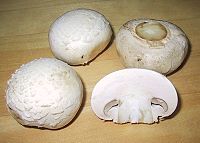
Photo from wikipedia
In autumn 2018, cap discoloration and browning symptoms (up to 20% incidence) were observed on commercially grown white button mushrooms (Agaricus bisporus) in two distinct farms located in Shiraz and… Click to show full abstract
In autumn 2018, cap discoloration and browning symptoms (up to 20% incidence) were observed on commercially grown white button mushrooms (Agaricus bisporus) in two distinct farms located in Shiraz and Marvdasht Counties in Southern Iran. Symptomatic caps (13 and six caps from Shiraz and Marvdasht Counties, respectively) were characterized by visible brown discoloration with no blotch symptoms, bacterial sticky mass and cap wilting. Isolation of bacterial strains from infected cap tissues was performed on yeast-extract peptone glucose agar (YPGA) according to Hamidizade et al. (2020). The resulted bacterial colonies were oyster-white in color, non-fluorescent, domed convex circular with smooth margins 1-2 mm in diameter. A total of six bacterial strains (Shiraz: Ir1002, Ir1003, Ir1004, Ir1005, Ir1007 and Marvdasht: Ir1027) were isolated from distinct mushroom samples. Standard biochemical and phenotypic analyses (Schaad et al. 2001) showed that the bacterial strains were Gram and oxidase negative, catalase positive and facultatively anaerobic, while no capsule or endospore was observed. All strains were positive in urease production, arginine dihydrolase, hydrolysis of tween 80, and utilization of sucrose and D-sorbitol, while they were negative in amylase, cellulose, lecithinase, pectinase, and protease production as well as casein hydrolysis. Based on these phenotypic characteristics, the strains were supposed to be members of Enterobacteriaceae. They also did not induce hypersensitive reaction (HR) on tobacco (Nicotiana tabacum cv. Turkish) leaves nor did they produce tolaasin when streaked side-by-side with "Pseudomonas reactans" strains on King B medium (Osdaghi et al. 2019). Pathogenicity of the strains was evaluated (repeated twice) on fresh caps of white button mushroom using cut-cap method (Hamidizade et al. 2020). Reference strains of Pseudomonas tolaasii (CFBP 8707) and Mycetocola spp. (CFBP 8708) were used as positive controls, while sterile distilled water was used as a negative control. Brown discoloration appeared 24-36 hours post inoculation on cap surfaces while control caps remained asymptomatic. Koch's postulates were accomplished by re-isolation and identification of bacterial strains from the symptomatic caps using colony morphology and Gram staining. For molecular identification, all initial as well as re-isolated strains were subjected to amplification and sequencing of 16S rDNA and gyrB (Yamamoto and Harayama 1995; Hamidizade et al. 2020). Obtained nucleotide sequences were deposited into NCBI GenBank (16S: MZ298620 to MZ298625; gyrB: MZ313184 to MZ313189). BLAST search using the 16S rDNA and gyrB sequences showed that the strains isolated in this study had 97-99% sequence similarity to the reference strains of Cedecea neteri. Phylogenetic analyses also confirmed close relationship of bacterial strains from this study to C. neteri strains. Pure cultures of representative strains Ir1004 (CFBP 8900) and Ir1027 (CFBP 8896) are deposited in CIRM-CFBP culture collection. This is the first report of C. neteri causing brown spot disease on button mushroom in Iran, while the bacterium has previously been reported to cause soft rot on Pholiota nameko (Yan et al. 2018), and yellow sticky disease on Flammulina velutipes (Yan et al. 2019) in China. Further comprehensive investigations will shed a light on the economic impact of the brown spot disease on mushroom industry in Iran.
Journal Title: Plant disease
Year Published: 2021
Link to full text (if available)
Share on Social Media: Sign Up to like & get
recommendations!